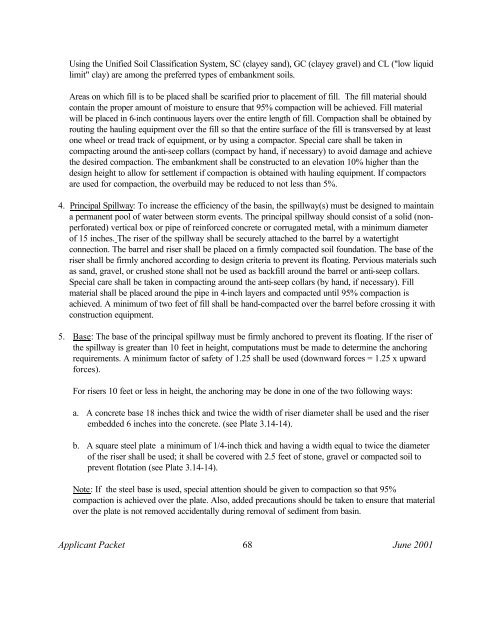APPLICANT PACKET - Virginia Department of Conservation and ...
APPLICANT PACKET - Virginia Department of Conservation and ...
APPLICANT PACKET - Virginia Department of Conservation and ...
You also want an ePaper? Increase the reach of your titles
YUMPU automatically turns print PDFs into web optimized ePapers that Google loves.
Using the Unified Soil Classification System, SC (clayey s<strong>and</strong>), GC (clayey gravel) <strong>and</strong> CL ("low liquid<br />
limit" clay) are among the preferred types <strong>of</strong> embankment soils.<br />
Areas on which fill is to be placed shall be scarified prior to placement <strong>of</strong> fill. The fill material should<br />
contain the proper amount <strong>of</strong> moisture to ensure that 95% compaction will be achieved. Fill material<br />
will be placed in 6-inch continuous layers over the entire length <strong>of</strong> fill. Compaction shall be obtained by<br />
routing the hauling equipment over the fill so that the entire surface <strong>of</strong> the fill is transversed by at least<br />
one wheel or tread track <strong>of</strong> equipment, or by using a compactor. Special care shall be taken in<br />
compacting around the anti-seep collars (compact by h<strong>and</strong>, if necessary) to avoid damage <strong>and</strong> achieve<br />
the desired compaction. The embankment shall be constructed to an elevation 10% higher than the<br />
design height to allow for settlement if compaction is obtained with hauling equipment. If compactors<br />
are used for compaction, the overbuild may be reduced to not less than 5%.<br />
4. Principal Spillway: To increase the efficiency <strong>of</strong> the basin, the spillway(s) must be designed to maintain<br />
a permanent pool <strong>of</strong> water between storm events. The principal spillway should consist <strong>of</strong> a solid (nonperforated)<br />
vertical box or pipe <strong>of</strong> reinforced concrete or corrugated metal, with a minimum diameter<br />
<strong>of</strong> 15 inches. The riser <strong>of</strong> the spillway shall be securely attached to the barrel by a watertight<br />
connection. The barrel <strong>and</strong> riser shall be placed on a firmly compacted soil foundation. The base <strong>of</strong> the<br />
riser shall be firmly anchored according to design criteria to prevent its floating. Pervious materials such<br />
as s<strong>and</strong>, gravel, or crushed stone shall not be used as backfill around the barrel or anti-seep collars.<br />
Special care shall be taken in compacting around the anti-seep collars (by h<strong>and</strong>, if necessary). Fill<br />
material shall be placed around the pipe in 4-inch layers <strong>and</strong> compacted until 95% compaction is<br />
achieved. A minimum <strong>of</strong> two feet <strong>of</strong> fill shall be h<strong>and</strong>-compacted over the barrel before crossing it with<br />
construction equipment.<br />
5. Base: The base <strong>of</strong> the principal spillway must be firmly anchored to prevent its floating. If the riser <strong>of</strong><br />
the spillway is greater than 10 feet in height, computations must be made to determine the anchoring<br />
requirements. A minimum factor <strong>of</strong> safety <strong>of</strong> 1.25 shall be used (downward forces = 1.25 x upward<br />
forces).<br />
For risers 10 feet or less in height, the anchoring may be done in one <strong>of</strong> the two following ways:<br />
a. A concrete base 18 inches thick <strong>and</strong> twice the width <strong>of</strong> riser diameter shall be used <strong>and</strong> the riser<br />
embedded 6 inches into the concrete. (see Plate 3.14-14).<br />
b. A square steel plate a minimum <strong>of</strong> 1/4-inch thick <strong>and</strong> having a width equal to twice the diameter<br />
<strong>of</strong> the riser shall be used; it shall be covered with 2.5 feet <strong>of</strong> stone, gravel or compacted soil to<br />
prevent flotation (see Plate 3.14-14).<br />
Note: If the steel base is used, special attention should be given to compaction so that 95%<br />
compaction is achieved over the plate. Also, added precautions should be taken to ensure that material<br />
over the plate is not removed accidentally during removal <strong>of</strong> sediment from basin.<br />
Applicant Packet 68<br />
June 2001
















